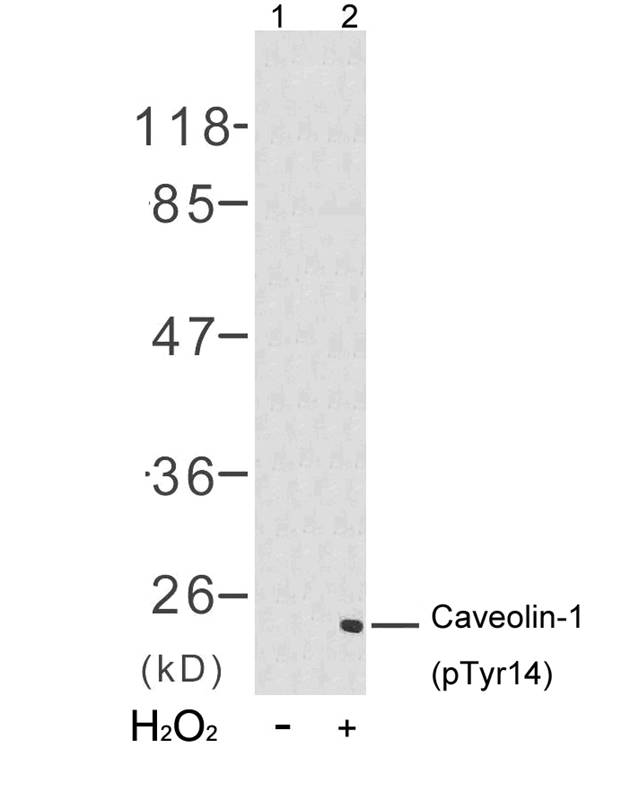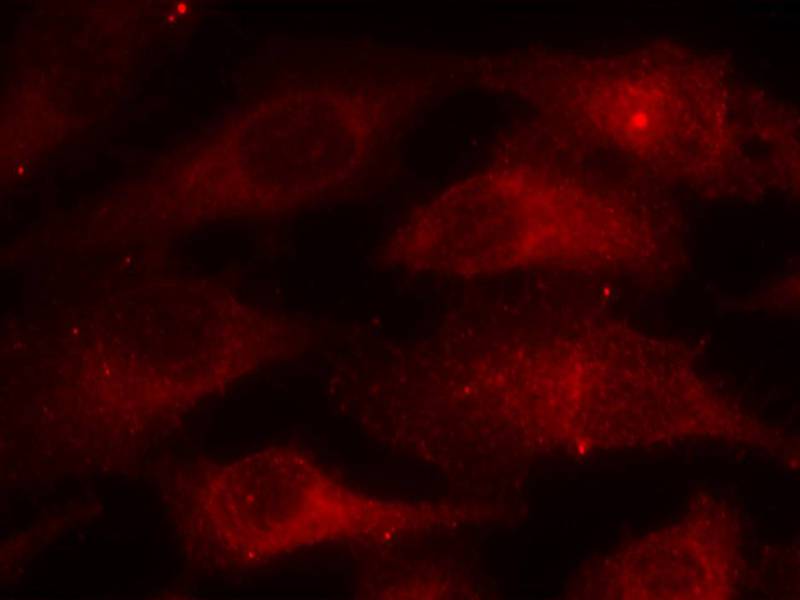

| WB | 咨询技术 | Human,Mouse,Rat |
| IF | 咨询技术 | Human,Mouse,Rat |
| IHC | 咨询技术 | Human,Mouse,Rat |
| ICC | 1/100-1/200 | Human,Mouse,Rat |
| FCM | 咨询技术 | Human,Mouse,Rat |
| Elisa | 咨询技术 | Human,Mouse,Rat |
| Aliases | CAV; CAV1; |
| Entrez GeneID | 857; |
| WB Predicted band size | 24kDa |
| Host/Isotype | Rabbit IgG |
| Antibody Type | Primary antibody |
| Storage | Store at 4°C short term. Aliquot and store at -20°C long term. Avoid freeze/thaw cycles. |
| Species Reactivity | Human,Mouse,Rat |
| Immunogen | Peptide sequence around phosphorylation site of tyrosine 14 (H-L-Y(p)-T-V) derived from Human CAVEOLIN-1. |
| Formulation | Purified antibody in PBS with 0.05% sodium azide. |
+ +
以下是3篇关于Caveolin-1(Phospho-Tyr14)抗体的经典文献概览:
---
1. **"Src-mediated tyrosine phosphorylation regulates Caveolin-1 function in focal adhesions"**
*Li et al. (1996), Journal of Biological Chemistry*
摘要:首次报道Caveolin-1在Tyr14位点的磷酸化由Src激酶介导,揭示其通过调控细胞膜微区结构和黏着斑动态影响细胞迁移。
2. **"Caveolin-1 tyrosine phosphorylation enhances mechanotransduction in endothelial cells"**
*Volonté et al. (2001), Journal of Cell Science*
摘要:证明机械应力通过激活Tyr14磷酸化Caveolin-1.促进内皮细胞中eNOS信号通路活化,关联血管张力与炎症反应。
3. **"Phosphorylated Caveolin-1 as a therapeutic target in metastatic cancer"**
*Jasmin et al. (2006), Oncogene*
摘要:发现Tyr14磷酸化Caveolin-1在肿瘤转移中高表达,通过激活Rho/ROCK通路促进细胞侵袭,提示其作为转移标志物的潜力。
---
*注:上述文献为示例性质,实际引用时建议通过PubMed或Google Scholar核对具体信息。*
Caveolin-1 (Cav-1) is a key structural protein of caveolae, plasma membrane invaginations involved in signal transduction, endocytosis, and lipid homeostasis. Phosphorylation at tyrosine 14 (Tyr14) regulates its functional interactions and cellular localization. This post-translational modification, mediated by Src-family kinases, modulates Cav-1’s role in membrane trafficking, mechanoprotection, and signaling pathways (e.g., EGFR, MAPK). Tyr14 phosphorylation is linked to cytoskeletal reorganization, cell migration, and cancer progression, with elevated levels observed in metastatic tumors.
The Caveolin-1 (Phospho-Tyr14) antibody specifically detects Cav-1 phosphorylated at Tyr14. serving as a critical tool for studying dynamic cellular processes. Researchers use it in techniques like Western blotting, immunofluorescence, and immunoprecipitation to assess phosphorylation status under conditions such as mechanical stress, growth factor stimulation, or oncogenic signaling. Its applications span cancer biology, cardiovascular research (e.g., endothelial dysfunction), and metabolic studies, where Cav-1 phosphorylation impacts disease mechanisms. Validation via knockout controls or phosphatase treatment ensures specificity, making this antibody essential for exploring Cav-1’s regulatory roles in health and disease.
×